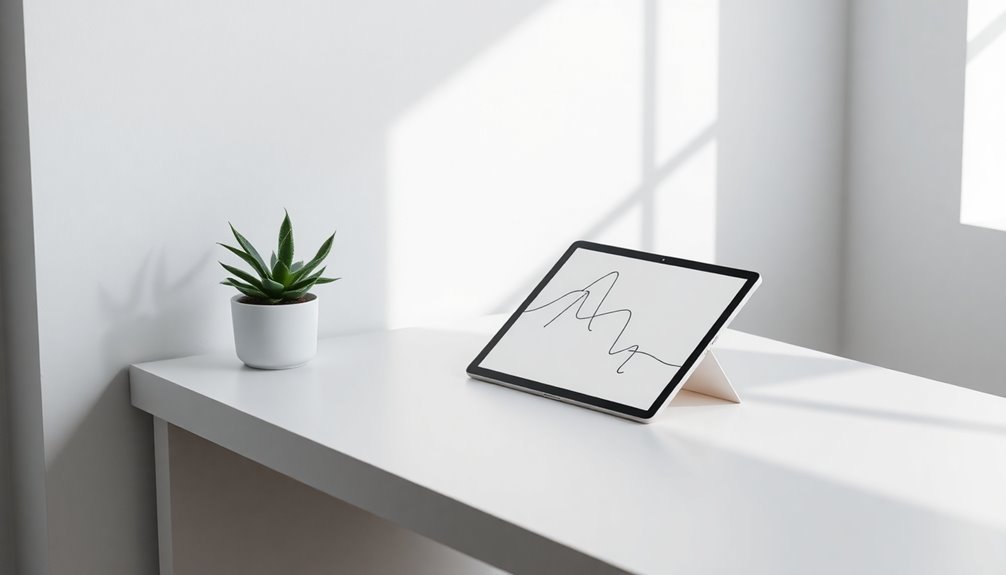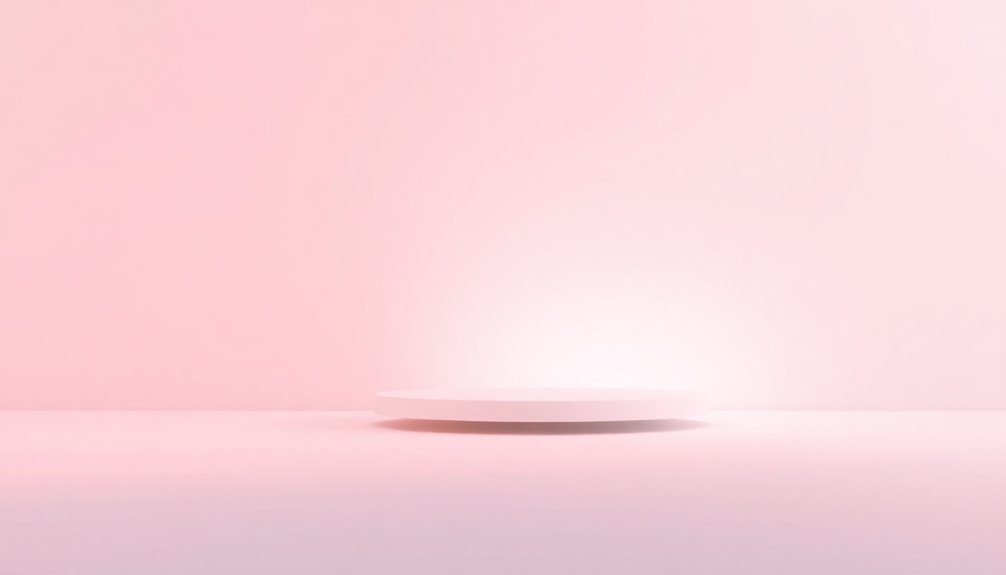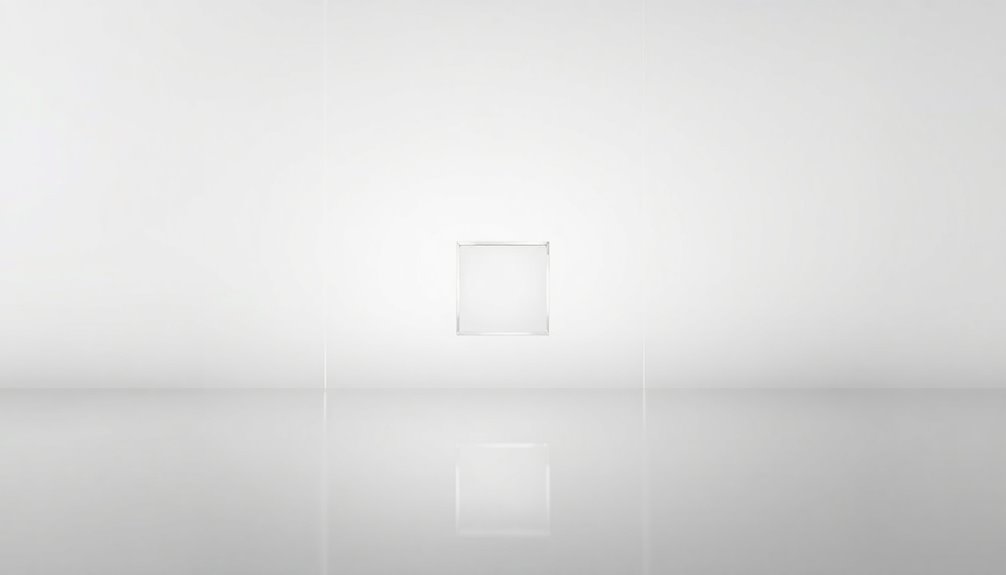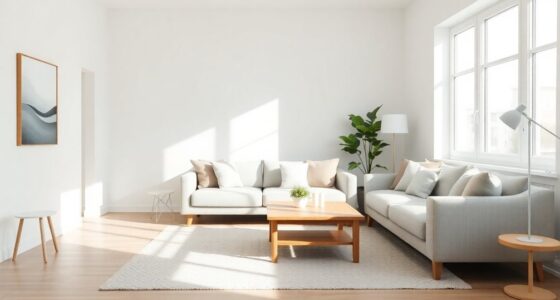If you're looking to showcase minimalist digital art, focus on simplicity and clarity. Limit your color palette to just two or three shades, and use negative space to highlight essential elements effectively. Implement clean lines and geometric shapes for a modern look, while maintaining a visual hierarchy with grids. This approach guarantees your art resonates with audiences who appreciate serenity and balance. Keep exploring these trends and techniques to elevate your minimalist creations even further.
Key Takeaways
- Minimalist digital art emphasizes essential elements, utilizing clean lines and geometric shapes for clarity and focus.
- Limited color palettes, often of two or three colors, enhance the modern aesthetic and improve visual impact.
- Negative space is crucial, directing attention to central themes while creating a serene and balanced composition.
- Organizing visual elements through grids and visual hierarchy promotes clarity and easier navigation of the artwork.
- Emerging trends include incorporating 3D materials and sustainable design choices while maintaining the core principles of minimalism.
Understanding Minimalist Digital Art

When you plunge into minimalist digital art, you'll notice it focuses on essential elements, stripping away the unnecessary to reveal clarity. This artistic style employs clean lines and geometric shapes, creating an uncluttered composition that enhances visual impact.
By utilizing negative space effectively, it directs your attention to the artwork's central theme, making the message easily digestible. Limited color palettes contribute to its modern aesthetic, ensuring that each element stands out without overwhelming the viewer.
As minimalist digital art gains traction in contemporary marketing, it aligns perfectly with audience preferences for simplicity and quick comprehension. This approach results in visually appealing designs that resonate with viewers, making it a powerful tool for artists and marketers alike. Additionally, effective use of space can also enhance the overall design in various interior settings.
Key Techniques for Creating Minimalist Art

Minimalist digital art thrives on simplicity, and mastering key techniques can elevate your creations.
Start by limiting your color palettes to two or three colors, enhancing clarity and reducing visual noise.
Limit your color palette to two or three hues for a clearer, more impactful design.
Utilize negative space effectively to draw attention to essential shapes, promoting a clean and simple aesthetic.
Implement grids and visual hierarchy to organize your visual elements, guiding the viewer's focus and ensuring intuitive navigation.
Choose clean, readable typography, sticking to two font styles to maintain minimalist design and improve accessibility.
Focus on effective communication by removing unnecessary elements, allowing your artistic expression to shine through. Additionally, embracing the Law of Attraction can inspire creativity and align your artistic vision with your personal goals.
The Role of Color in Minimalist Design

Color plays an essential role in minimalist design, shaping the overall mood and impact of your artwork. By using limited color palettes, typically two to three colors, you minimize visual noise, maintaining clarity.
Monochromatic color schemes offer a sleek, modern feel, while complementary color schemes create high contrast that highlights key elements. Pairing typography with neutral colors enhances readability, ensuring your message is clear.
The effective use of negative space alongside these restrained colors fosters balance, allowing viewers to focus on core ideas. Ultimately, the simplicity of your color choices promotes a serene visual experience, resonating with audiences who appreciate tranquility.
In minimalist design, every color decision counts, helping you communicate your vision powerfully and effectively. Additionally, integrating color coordination can enhance overall design aesthetics, making your artwork more visually appealing.
Embracing Negative Space in Digital Art

Negative space is a powerful tool in digital art that can elevate your work to new heights. By embracing negative space, you create a clean and minimalist aesthetic that enhances balance among visual elements.
This organization allows your audience to navigate your artwork easily, directing their focus to essential components. When used effectively, negative space boosts clarity, reinforcing the principle that less is more.
You can evoke emotional impact and serenity, aligning your designs with contemporary trends that emphasize calm and mindfulness. Eucalyptus oil is known for its ability to promote relaxation, much like the serene feeling evoked through effective use of negative space in art.
By strategically incorporating negative space, you not only enhance the overall aesthetics of your art but also convey messages more clearly, making your work resonate deeply with viewers.
Embrace this technique to transform your digital art practice.
The Future of Minimalism in Digital Art

As the landscape of digital art evolves, the principles of minimalism continue to shape its future.
You'll notice that minimalist graphic design is adapting to modern life, embracing sustainable design choices and environmentally friendly materials. Emerging trends will incorporate 3D materials, adding depth while keeping visuals clear and simple.
This shift allows for unique visual experiences without losing the essence of minimalism. As artificial intelligence streamlines the design process, you'll find artists focusing on core concepts, enhancing comprehension through a single, clear message. High contrast ratios can also play a role in creating striking minimalist visuals by ensuring deeper blacks and brighter whites.
The enduring nature of minimalism will resonate with audiences, ensuring it remains a crucial art form. Emphasizing negative space will further highlight the beauty of simplicity, making minimalism a timeless choice in digital art.
Frequently Asked Questions
What Are the Techniques of Minimalist Art?
When exploring minimalist art techniques, you'll notice the importance of negative space, which creates balance and highlights essential elements.
Using a limited color palette helps reduce visual noise and maintain a modern look.
You'll want to choose clean typography, usually sticking to two styles for better readability.
Implementing grids organizes your content and establishes a visual hierarchy, guiding the viewer's focus and making it easier for them to grasp key information quickly.
What Techniques Are Used in Minimalism?
Creating minimalist art is like crafting a delicate balance on a tightrope. You focus on a limited color palette, usually just two or three tones, to avoid clutter.
Negative space plays a crucial role, guiding the viewer's eye to key elements. You'll favor clean typography, sticking to two font styles for clarity.
Grids help you organize your design, while visual hierarchy through size and color directs attention effectively, ensuring your message shines.
What Is the Minimalism Design Trend?
Minimalism in design is all about simplicity. You focus on stripping away unnecessary elements to highlight essential forms.
By using basic shapes and a limited color palette, you create clarity and impact. This trend emphasizes effective use of negative space and clean typography, enhancing user experience.
It's gained popularity since the 1960s, remaining relevant as it helps people retain attention and absorb information, especially in today's crowded digital environments.
What Are the Three Characteristics of Minimalism Art?
Imagine walking through a serene forest, where every tree stands tall, yet none crowd each other.
That's the essence of minimalism art.
You'll notice three key characteristics: the reduction of elements to their simplest forms, often using geometric shapes; a restrained color palette that evokes emotion; and the effective use of negative space, which enhances balance and focus.
These elements create a clean, contemplative experience that invites you to reflect deeply.
Conclusion
In the world of digital art, embracing minimalism lets your creativity shine like a beacon in the night. By understanding its core principles and techniques, you can craft pieces that not only speak volumes but also resonate deeply with your audience. As you explore color and negative space, remember that less truly can be more. As the future unfolds, let your minimalist art be a gentle whisper that captivates hearts and sparks conversations. Keep creating!









